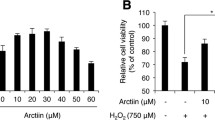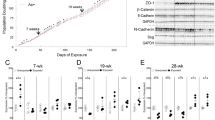Abstract
p-Phenylenediamine (PPD), a black dye used in hair coloring and tattoos, irritates the skin, leading to cell cycle arrest, apoptosis, and reactive oxygen species (ROS) generation. MicroRNAs (miRNAs) are well known regulators of these side effects. The aim of the present study was to evaluate PPD-induced miRNA expression profile alterations in human keratinocytes. First, we demonstrated that PPD reduced HaCaT cell viability by inducing cell cycle arrest and death, elevating cellular ROS levels and decreasing the migration rate. In addition, 67 miRNAs were upregulated by at least 5-fold in PPD-treated HaCaT cell and 17 miRNAs were downregulated by at least 5- fold in PPD-treated HaCaT cell. Using bioinformatics, we identified a relationship between PPD-mediated miRNA changes and cell death, cell cycle arrest, generation of ROS, and migration repression. Target genes of PPD-regulated miRNAs were involved in cell proliferation, apoptosis, skin development, and aging. Thus, our results establish a role for miRNAs in regulating PPD-induced cell death, cell cycle arrest, ROS generation, and repression of migration in human keratinocytes.
Similar content being viewed by others
References
Lawrence, N. S., Beckett, E. L., Davis, J. & Comptonm, R.G. Voltammetric investigation of hair dye constituents: application to the quantification of p-phenylenediamine. Analyst 126:1897–900 (2001).
Corbett, J. F. An historical review of the use of dye precursors in the formulation of commercial oxidation hair dyes. Dyes Pigments 41:127–136 (1999).
Brown, K. C. in Hair and Hair Care (eds Johnson, D.) 191–215 (Marcel Dekker, New York, 1997).
Gendler, E. Adverse reaction to cosmetics. Cutis 39: 525–526 (1987).
Moeller, R., Lichter, J. & Blömeke, B. Impact of paraphenylenediamine on cyclooxygenases expression and prostaglandin formation in human immortalized keratinocytes (HaCaT). Toxicology 249:167–175 (2008).
Eilstein, J., Giménez-Arnau, E., Duché, D., Rousset, F. & Lepoittevin, J. P. Mechanistic studies on the lysine-induced N-formylation of 2,5-dimethyl-p-benzoquinonediimine. Chem Res Toxicol 20:1155–1161 (2007).
McFadden, J. P., Yeo, L. & White, J. L. Clinical and experimental aspects of allergic contact dermatitis to para-phenylenediamine. Clin Dermatol 29:316–324 (2011).
So, J. Y., Shin, C. Y., Song, M., Rha, Y. A. & Ryu, J. C. Gene expression profiling of hair-dying agent, paraphenylenediamine, in human keratinocytes (HaCaT) cells. Mol Cell Toxicol 7:339–346 (2011).
Moeller, R., Lichter, J. & Blömeke, B. Impact of paraphenylenediamine on cyclooxygenases expression and prostaglandin formation in human immortalized keratinocytes (HaCaT). Toxicology 249:167–175 (2008).
Chung, K. T. et al. Mutagenicity and toxicity studies of p-phenylenediamine and its derivatives. Toxicol Lett 81:23–32 (1995).
Chye, S. M. et al. Apoptosis induced by para-phenylenediamine involves formation of ROS and activation of p38 and JNK in chang liver cells. Environ Toxicol 29:981–990 (2014).
Sontheimer, E. J. & Carthew, R. W. Silence from within: endogenous siRNAs and miRNAs. Cell 122:9–12 (2005).
Hooff, G. P. et al. Analytical Investigations of Toxic p-Phenylenediamine (PPD) Levels in Clinical Urine Samples with Special Focus on MALDI-MS/MS. PLoS One 6:e22191 (2011).
Tsutsumi, S. et al. Gastric irritant-induced apoptosis in guinea pig gastric mucosal cells in primary culture. Biochim Biophys Acta 1589:168–180 (2002).
Nakai, K., Yoneda, K. & Kubota, Y. Oxidative stress in allergic and irritant dermatitis: from basic research to clinical management. Recent Pat Inflamm Allergy Drug Discov 6:202–209 (2012).
Jovanovic, M. & Hengartner, M. O. miRNAs and apoptosis: RNAs to die for. Oncogene 25:6176–6187, (2006).
Bueno, M. J. & Malumbres, M. MicroRNAs and the cell cycle. Biochim Biophys Acta 1812: 592–601 (2011).
Xu, S. et al. Oxidative stress mediated-alterations of the microRNA expression profile in mouse hippocampal neurons. Int J Mol Sci 13:16945–16960 (2012).
Cui, L. et al. MicroRNA-99a induces G1-phase cell cycle arrest and suppresses tumorigenicity in renal cell carcinoma. BMC Cancer 12:546 (2012).
Liu, Q. et al. miR-16 family induces cell cycle arrest by regulating multiple cell cycle genes. Nucleic Acids Res 36:5391–5404 (2008).
Cimmino, A. et al. miR-15 and miR-16 induce apoptosis by targeting BCL2. Proc Natl Acad Sci U S A 102:13944–13949 (2005).
Zhang, X. et al. MicroRNA-21 modulates the levels of reactive oxygen species levels by targeting SOD3 and TNFa. Cancer Res 72:4707–4713 (2012).
An, Y. R. & Hwang, S. Y. Toxicology study with microRNA. Mol Cell Toxicol 10:127–134 (2014).
Lema, C. & Cunningham, M. J. MicroRNAs and their implications in toxicological research. Toxicol Lett 5:100–105 (2010).
Chen, S. C. et al. p-Phenylenediamine induces p.53- mediated apoptosis in Mardin Darby canine Kidney cells. Toxicol In Vitro 20:801–807 (2006).
Chen, S. C. et al. Para-phenylenediamine induced DNA damage and apoptosis through oxidative stress and enhanced caspase-8 and-9 activities in Mardin-Darby canine kidney cells. Toxicol In Vitro 24:1197–1202 (2010).
Ohdaira, H., Sekiguchi, M., Miyata, K. & Yoshida, K. MicroRNA-494 suppresses cell proliferation and induces senescence in A549 lung cancer cells. Cell Prolif 45:32–38 (2012).
Romano, G. et al. MiR-494 is regulated by ERK1/2 and modulates TRAIL-induced apoptosis in non-smallcell lung cancer through BIM down-regulation. Proc Natl Acad Sci U S A 109:16570–16575 (2012).
Saini, S. et al. MicroRNA-708 induces apoptosis and suppresses tumorigenicity in renal cancer cells. Cancer Res 71:6208–6219 (2011).
Wada, T. & Penninger, J. M. Mitogen-activated protein kinases in apoptosis regulation. Oncogene 23: 2838–2849 (2004).
Zhang, W. & Liu, H. T. MAPK signal pathways in the regulation of cell proliferation in mammalian cells. Cell Res 12:9–18 (2002).
Author information
Authors and Affiliations
Corresponding author
Rights and permissions
About this article
Cite this article
Cha, H.J., Lee, OK., Kim, S.Y. et al. MicroRNA expression profiling of p-phenylenediamine treatment in human keratinocyte cell line. Mol. Cell. Toxicol. 11, 19–28 (2015). https://doi.org/10.1007/s13273-015-0003-9
Received:
Accepted:
Published:
Issue Date:
DOI: https://doi.org/10.1007/s13273-015-0003-9




